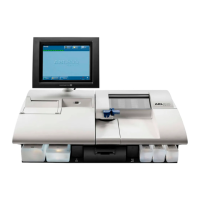ABL800 FLEX Operator's Manual 12. Sampling
Preparation prior to capillary sampling
Capillary
sampling sites
The following are recommended capillary sampling sites:
• Earlobe • Fetal scalp
• Finger tip • Heel*
• Big toe*
* The heel and big toe should not be used on patients older than six months.
NOTICE: In general, results obtained from capillary samples, particularly pO
2
values, should be interpreted with caution.
Capillary
sampling
guidelines
The guidelines for capillary sampling are as follows:
•
Arterialize the puncture site by warming it up to approximately 42 °C for 5
to 10 minutes prior to actual sampling. Failure to do so will make the blood
sample only representative of the local tissue, and not the general status of
the patient.
Make a puncture using a lancet or the like, so that blood flows freely. Do not
squeeze the area.
•
Remove the first drop of blood, since it may be diluted with tissue fluid.
Take the sample from the center of the second blood drop. To prevent air
from entering the capillary, take the sample from the center of the drop.
•
Squeezing or milking the puncture site is to be avoided as this will result in
an admixture of blood and tissue fluid, resulting in faulty measurements. It
can also cause hemolysis of the blood sample (or part of the sample),
resulting in cK
+
readings being too high.
•
Mix the sample with heparin immediately after collection to prevent blood
from clotting. (Clots can clog the analyzer and cause unnecessary
downtime.) Use a mixing wire and magnet when mixing a capillary sample.
•
WARNING – Risk of infection
Disposal of used
sampling devices
Discard the waste as infectious waste [4].
12-7

